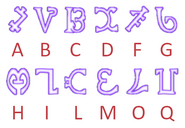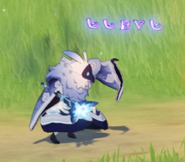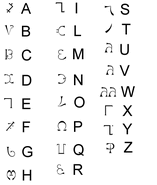While playing Genshin Impact, players can find many different languages and scripts while exploring Teyvat, most of which are based on real-world languages. This article covers scripts which players can see while playing the game and is not necessarily comprehensive of all languages which exist in the world of Teyvat.
Aside from Hilichurlian and Ishine Script, all language names are unofficial.
Teyvat Script[]

The Teyvat common language alphabet
The Teyvat Script (unofficial name) (also implied to be the common script[1]) is the writing system that appears in the open world in Teyvat, especially in Mondstadt and Liyue, as well as in Tutorial images. It is likely to be the universal script across Teyvat.
Hilichurlian[]
Hilichurlian is one of the main languages of Teyvat spoken and is spoken predominantly by hilichurls.
Liyue Script[]

Example of the Liyue written language.
The Liyue Script (unofficial name) refers to the writing system of Liyue.
The script is inspired by real-life Chinese characters, particularly seal script. Such script is common in Liyue Harbor around shops and other businesses — there is a very high degree of repetition of these symbols between shop signs.[Note 1] Other examples of this script can be seen on the Jade Chamber Intel Wall during the animated cutscene in the Archon Quest Zhongli's Treat in Chapter I: Act II - Farewell, Archaic Lord and on bulletin boards around Liyue.
Inazuman Script[]
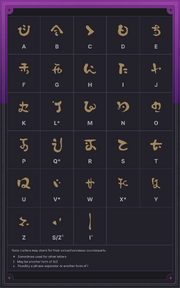
The Inazuman Alphabet
The Inazuman Script (unofficial name) refers to the writing system of Inazuma.
The script is based on the Teyvat alphabet[2] and appears to be inspired by Japanese hiragana. It can be found written vertically from top-to-bottom, right-to-left, as with various traditional East Asian scripts, or it can be written horizontally. The glyphs used in the Inazuma script correspond to letters of the Latin alphabet instead of Japanese kana. The texts written in this script are based on romanized Japanese.
Sumeru Script[]
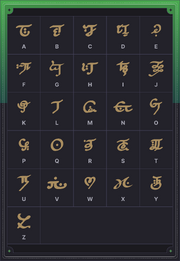
The Sumeru Alphabet
The Vedanagari Script refers to one of the writing systems of Sumeru.
This script seems to be based on the Teyvat alphabet and appears to be inspired by Devanagari script, which is used most notably in India. This language is generally used to write English words and sentences, but unlike English, there appears to be no distinct letter case or punctuation.
Deshret Script[]
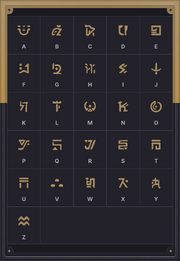
The Deshret Alphabet
The Deshret Script refers to the writing system found in the ruins in the Great Red Sand.
This script seems to be based on the Teyvat alphabet and appears to be inspired by Egyptian hieroglyphs. This language is generally used to write Egyptian words and sentences.
Fontaine Script[]
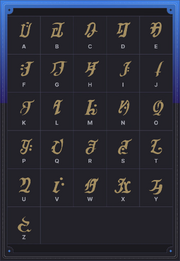
The Fontaine Alphabet
The Fontainian script[3] refers to Fontaine's current writing script.
The script heavily resembles the Teyvat Script, which is most commonly found in Mondstadt.
Latin-Based Language[]
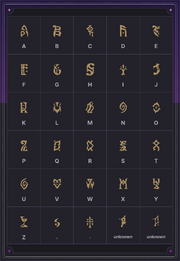
The alphabet of the unknown Latin language.
The Latin-Based Language (unofficial name), popularly known as the Abyss Language (unofficial name), can be found all over Teyvat, usually in non-mundane inscriptions such as those relating to gods, alchemy, astrology, and in association with Ley Lines; it also appears when magical seals appear, such as on some chests. The alphabet is based on Latin letters like the common written language of Teyvat, but the words and grammar are based on Classical Latin instead of English. Although there is no capitalization, there is punctuation.[4] Additionally, some versions of this alphabet are associated with the Abyss Order — and it may be that this was the script of Khaenri'ah.[5][6]
Other Languages[]
Mondstadt Script[]
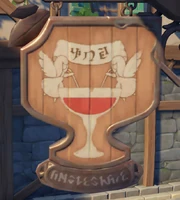
Example of the Mondstadt Language at the bottom of the sign
Certain signs in Mondstadt appear to use a script that is not the Teyvat Script. These signs have words written using the Roman alphabet with certain sections removed and the entire written item flipped horizontally. There is also variation between likely instances of the same letter.
Signs with this script:
- An emblem of the Mondstadt branch of the Adventurers' Guild emblem; likely reads "Monde [sic]" ("MOnDE")
- Logo of the Angel's Share; likely reads "Angle Share [sic]" ("ANGLEShArE")
- Inn sign; likely reads "Inn" ("Inn")
Enochian-Based Language[]
The script for this language appears while Abyss Mages are chanting to regenerate their shields as well as over their heads when performing spells outside of combat, whether alone or in the company of hilichurls such as in the Commission Spreading Evil. This is likely the long-forgotten language mentioned in the Adventurer Handbook as what gives the Abyss Mages their magical power. The script is based on the Enochian alphabet, but attempts to decrypt it have only yielded unintelligible text, as the letter sequences appear to be randomly generated.
The script also appears in the yellow protective runes around the weak points of Automatons, where the mirrored glyphs for B, L, and G circle around the core. Ruin Guards are known to have been made by the people of Khaenri'ah,[7] many of whom turned into "monsters of the Abyss,"[8] so this script was possibly used in Khaenri'ah as well.
There is only one instance of the Enochian-based language being transcribed into another discernible language: In the cinematic at the end of Archon Quest Crash Course in Prologue: Act I - The Outlander Who Caught the Wind, the Hydro Abyss Mage says a line that is transcribed in the subtitles as "Gohus, Chiso Vonph" in the Roman alphabet, regardless of the player's set language. This translates from Enochian as something along the lines of "I say, they are angry." While the line itself does not appear otherwise, the Hydro Abyss Mage says the line while performing an animation similar to the shield regeneration animation, during which letters from the alphabet appear. The same line can also be heard by players in regular gameplay when Abyss Mages finish regenerating their shields.
Runes[]
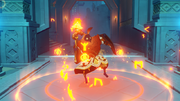
Example of Runes where symbols including ᛉ and ᛗ can be seen
Runes resembling Elder Futhark runes can be seen in the Tutorial images for the Abyss Mages, seemingly when they are about to regenerate their shields. However, since Version 1.0, the symbols that appear around Abyss Mages are in the Enochian-based language instead.
Adeptus Script[]
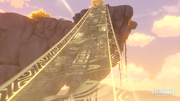
Example of the Adeptus Script
This script has only been found on Adeptus Bridges. It is presumably used by the Adepti.
Ishine Script[]
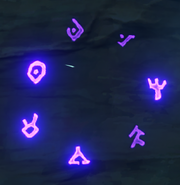
The seven letters of the Ishine Script
The Ishine Script was only known by the priestly families in the civilization that once inhabited Tsurumi Island.[9] The language of the script was used to name people, places, and other things on the island.[10] This language is likely based on the Ainu language in real life. For example, Kama means "a very big rock," which corresponds to the Ainu word カマ kama, meaning "flat rock." However, the letters of the Ishine Script do not bear any obvious similarities to Ainu writing.
Tanuki Language[]
According to Ioroi, Tanuki can understand human speech by nature, but also possess their own language amongst themselves. Ioroi is able to prepare a magical food which allows Traveler to understand some Tanuki speech but much of it still comes out as gibberish such as when Kichiboushi says "squelch squelch lavender melon." According to Ioroi, this confusion is caused by the Traveler having yet to be accustomed to Kichiboushi's aura, a statement which is supported by the fact that communication with Kichiboushi gets clearer throughout the journey with him.
Aranara Language[]
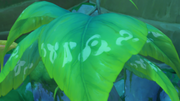
Example of the Aranara Language written on a Silapna Leaf
The Aranara Language (unofficial name) is the language spoken by the Aranara of Sumeru. The Aranara often include words from this language while speaking. It also appears that there may be a script for this language written in multiple Aranara inscriptions, such as the text found on the Silapna's leaf, or the text written on multiple walls.
The language's lexicon appears to be based on Sanskrit. For example, the Aranara term for human or person, "Nara," likely comes from नर nara, "human, person." Similarly, the Aranara word for Spinocrocodile, "Apshvaana," is Sanskrit for "water dog" and derives from अप् ap, "water" and श्वान śvāna, "dog."
Ciphers[]
Jade Chamber[]
If you decipher the series of numbers in the Strange Notebook you get "The Fatui will strike the Golden House". The text can be deciphered by referring a book about Rex Lapis's death that can be found on Ningguang's desk. The code numbers are a modified book cipher, written in the format [sentence]:[word]:[letter]|[letter]. The letters from these codes will spell out the message.
Cryptic Message in Dragonspine[]
Nine Ruin Guards located throughout Dragonspine contain cryptic Record of Serial No. messages that can be deciphered to read "For the nation, we can't forgo this skyborne power, but we failed."
Cryptic Message in Sumeru[]
Five Ruin Guards located throughout Sumeru contain cryptic messages that can be deciphered to read "We Schwanenritters have fought to the last one."
Real Life Languages[]
So far, the following real life languages have been used extensively, although none appear in written form in the world of Genshin Impact as they do in real life:
| Language | Primarily seen in relation to... |
|---|---|
| Ainu | Tsurumi Island |
| Arabic | Sumeru |
| Chinese | Liyue |
| Egyptian | Great Red Sand (Sumeru) |
| English | Mondstadt |
| French | Fontaine |
| German | Mondstadt |
| Greek | Enkanomiya |
| Japanese | Inazuma |
| Latin | Sea of Bygone Eras, Abyssal spells |
| Persian | Dharma Forest (Sumeru) |
| Russian | Snezhnaya |
| Sanskrit | Dharma Forest (Sumeru) |
Other real life languages that have been used include the following (examples are non-exhaustive):
- Dutch (Vermeer)
- Finnish (Ukko)
- Hebrew (Names of the Hypostases, Teyvat)
- Hindustani (Kaushik)
- Hungarian (Orban)
- Italian (Names of the Eleven Fatui Harbingers, Lisa Minci, Navia)
- Old Norse (Sal Vindagnyr, Imunlaukr, Gunnhildr, Ragnvindr, Ulfr, Ylgr)
- Old Slavic (Krsnik Noc)
- Spanish (Six-Fingered José)
- Romanian (Cosanzeana)
Manga-Only Scripts[]
The Genshin Impact manga was published from 2018 to 2019, before the official global launch of the game.
Common Script[]
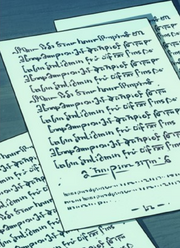
Letter read by Il Dottore in Chapter 9 of the manga
An indecipherable script can be seen in papers throughout the manga, such as in the letter that Il Dottore receives from the Knights of Favonius in Chapter 9. It is likely a written lingua franca.
As this script has not been seen in official media since Genshin Impact's launch and all instances of the script appear to be filler text due to repetition of the same lines, this script was likely a placeholder and ultimately scrapped.
Prologue Script[]

The magic circle that Venti arose from in the prologue of the manga
In the manga's prologue, Venti arises from a magic circle with an unknown script within it.
This script has not been seen in-game or in official media since Genshin Impact's launch. It may have been scrapped or updated.
English[]
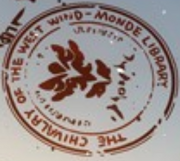
Stamp seen in Chapter 5 of the manga
In Chapter 5 of the manga, there is a circular stamp reading "THE CHIVALRY OF THE WEST WIND - MONDE LIBRARY" in English.
The regular use of English as-is has likely been scrapped.
Ancient Script[]
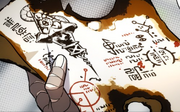
Ancient language in a Fatui document seen in Chapter 6 of the manga
In the manga, there is a partially burned two-sided Fatui document about Crepus Ragnvindr's Delusion and the syringe that was used on Collei. The content pertaining to the Delusion was written in the common script, as it appears to use the same written script and Amber and Jean both read it,[11] but the content pertaining to the syringe was written in an "ancient language."[12] It has dots and a blocky style like the Deshret Script. The Liyue Script also has a similar blocky style but has no dots.
This script has not been seen in-game or in official media since Genshin Impact's launch. It may have been scrapped or updated.
Trivia[]
- There are very few instances of any existing scripts on Earth appearing as-is in the world of Teyvat. The only known instances are:
- The Roman Alphabet
- Playing cards found on tables in Angel's Share[where?]
- Tattered Paper image, which appears to say "S to J" in the bottom right
- Layla's List of Orders image, which may say "Quest!" on the first line
- Diona's collar with her initial written on the tag.
- Arabic numerals
- Found in the 2/4 time signature asset along with other Western musical notation; used in various musical contexts, including but not limited to:
- Barbara's Elemental Skill
- Speakerphones in the Veluriyam Mirage
- A panel at the top of Constellation Metropole
- Found in the 2/4 time signature asset along with other Western musical notation; used in various musical contexts, including but not limited to:
- Chinese characters
- The Unusual Hilichurl has a Simplified Chinese character on its mask as a reference to Liu Wei, one of HoYoverse's co-founders.
- The Balladeer has a stylized version of the kanji/hanzi character 惡, meaning “evil”, on the veil of his hat.
- The Roman Alphabet
Notes[]
- ↑ The sign for the Zhongyuan Chop Suey stall, the sign for the unnamed building next to this stall, the sign for Xigu Antiques and all legible characters on the scrolls, the signs for Yanshang Teahouse, the sign for the Dockyard, the signs for Mingxing Jewelry and all characters on the scrolls, the sign for Northland Bank, the hanging banners in Bubu Pharmacy, and the books at Wanwen Bookstore all share the same eight symbols. Notable exceptions are the last symbol on the banner for Wanmin Restaurant, and the symbols for Wanwen Bookstore.
References[]
- ↑ World Quest: The Phaethons' Syrtos
- ↑ Bilibili: 【原神考据】稻妻文破解初步
- ↑ Interactable, Tower of Ipsissimus: Bottom: Investigation Log
- ↑ NGA: Deciphering of the Khaenri'ah Alphabet (Reddit: English translation)
- ↑ Archon Quest, Chapter I, Act IV - We Will Be Reunited, Part 2: A Herald Without Adherents
- ↑ World Quest, The Chasm Delvers: Perils in the Dark
- ↑ Archon Quest, Chapter I, Act IV - We Will Be Reunited, Part 2: A Herald Without Adherents
- ↑ Archon Quest, Chapter I, Act IV - We Will Be Reunited, Part 4: A Soul Set Apart
- ↑ World Quest, Through the Mists: Octave of the Maushiro
- ↑ World Quest, Through the Mists: The Sun-Wheel and Mt. Kanna
- ↑ Manga, Chapter 6: Wind and Fyre (Part 1)
- ↑ Manga, Chapter 8: Final Clue (Part 1)
[]
| |||||||||||||||||||||||||||||||||||
| |||||||||||||||||||||||||||||||||||||||||||||||||||||||||||||||||||||||||||||||||||||||||||||||||||||||||||||||||||||

